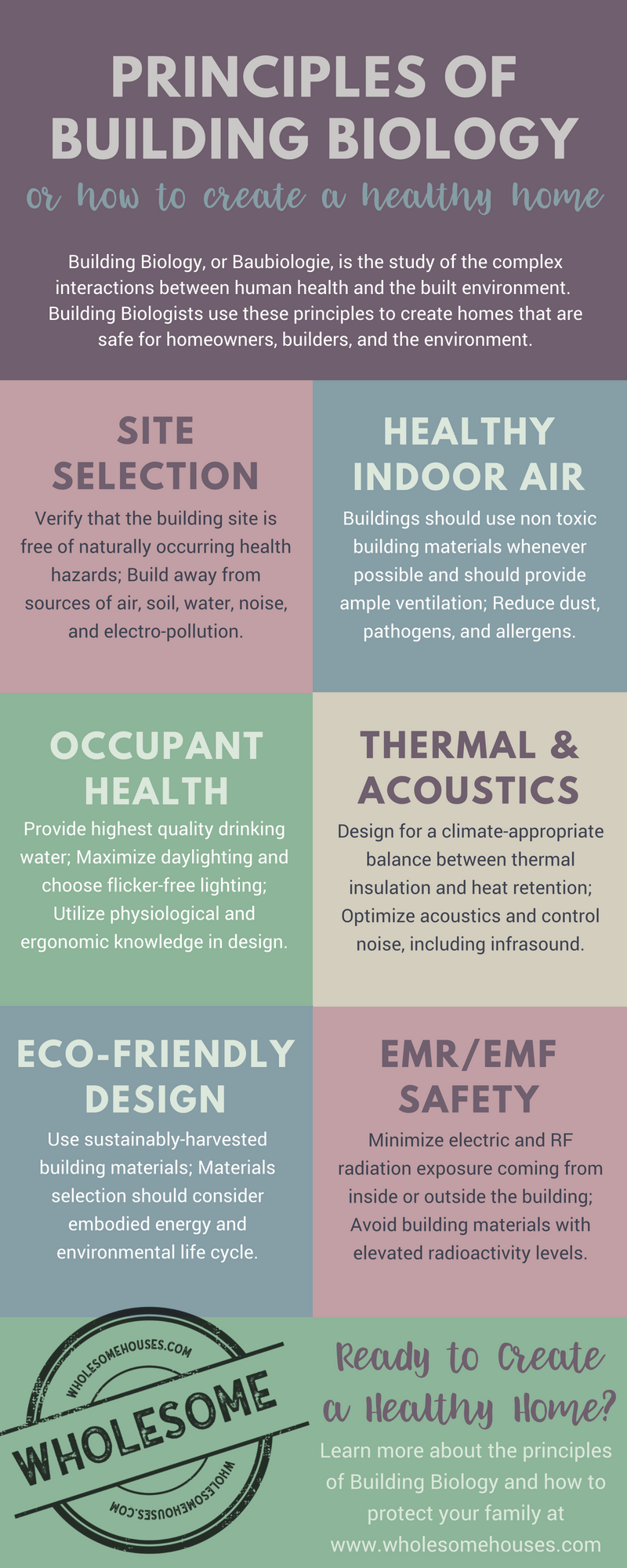
I am currently studying to become a Building Biologist. But I’ve never met a single person who has any idea what that means. So what is building biology (also called baubiologie), anyway?
Simply put, building biology is the study of the complex interactions between human health and the built environment.
Why I Believe Healthy Buildings Are Important
When you think of optimum human health, what comes to mind? A regular fitness routine, meditation, perhaps? And I would agree that these things are highly important to living a healthy life. But I would argue that without addressing the risks inside your own home, you are not reaching your full potential.
Building biology seeks to eliminate unnecessary burdens on the body, including electromagnetic radiation, toxic finishes and furnishings, polluted drinking and bathing water, and poor indoor air quality, to name a few.
As you probably know, our bodies are incredible machines which were built to heal themselves, given the right conditions. But most of this rest and repair happens as we sleep. And most bedrooms (and homes in general) are simply not conducive to this.
The 25 Principles of Building Biology
Site & Community Design
- Verify that the site is free of naturally occurring health hazards.
- Place dwellings so occupants are undisturbed by sources of man-made air, soil, water, noise and electro-pollution.
- Place dwellings in well-planned communities that provide ample access to fresh air, sunshine and nature.
- Plan homes and developments considering the needs of community, families and individuals of all ages.
Occupant Health & Wellbeing
- Use natural and unadulterated building materials.
- Allow natural self-regulation of indoor air humidity using hygroscopic (humidity buffering) building materials.
- Assure low total moisture content and rapid desiccation of wet construction processes in new buildings.
- Design for a climatically appropriate balance between thermal insulation and thermal storage capacity.
- Plan for climatically appropriate surface and air temperature.
- Provide for ample ventilation.
- Use appropriate thermal radiation strategies for heating buildings including passive solar wherever viable.
- Provide an abundance of well-balanced natural light and illumination while using color in accordance with nature.
- Provide adequate acoustical protection from harmful noise and vibration.
- Utilize non-toxic building materials that have neutral or pleasant natural scents.
- Use appropriate water and moisture exclusion techniques to prevent interior growth of fungi, bacteria, dust and allergens.
- Assure best possible potable water quality by applying purification technologies if required.
- Utilize physiological and ergonomic knowledge in interior and furniture design.
- Consider proportion, harmonic measure, order and shape in design.
Electro-Magnetic Radiation Safety
- Minimize indoor interference with vital cosmic and terrestrial radiation.
- Minimize man-made power system and radio frequency radiation exposure generated from within the building and from outside sources.
- Avoid use of building materials that have elevated radioactivity levels.
Environmental Protection, Social Responsibility & Energy Efficiency
- Construction materials production and building processes shall provide for health and social well-being in every phase of the building’s life-cycle.
- Avoid the use of building materials that deplete irreplaceable natural resources or are being harvested in an unsustainable manner.
- Minimize energy consumption throughout the life of the building utilizing climate-based and energy efficient design, energy and water saving technologies and renewable energy.
- Consider the embodied energy and environmental life cycle costs when choosing all materials used in construction.
Where to Find a Local Building Biologist
If you would like a trained practitioner to assess the human health risks of your home or office, you can locate a local Building Biologist through the International Institute for Building-Biology and Ecology.
Oh, and if you’re in the Northwest Florida area, I am currently accepting new clients!
8 Healthy Home Tests

Subscribe to my email list and get my free report, How to Measure & Monitor the Health of Your Home






Leave a Comment